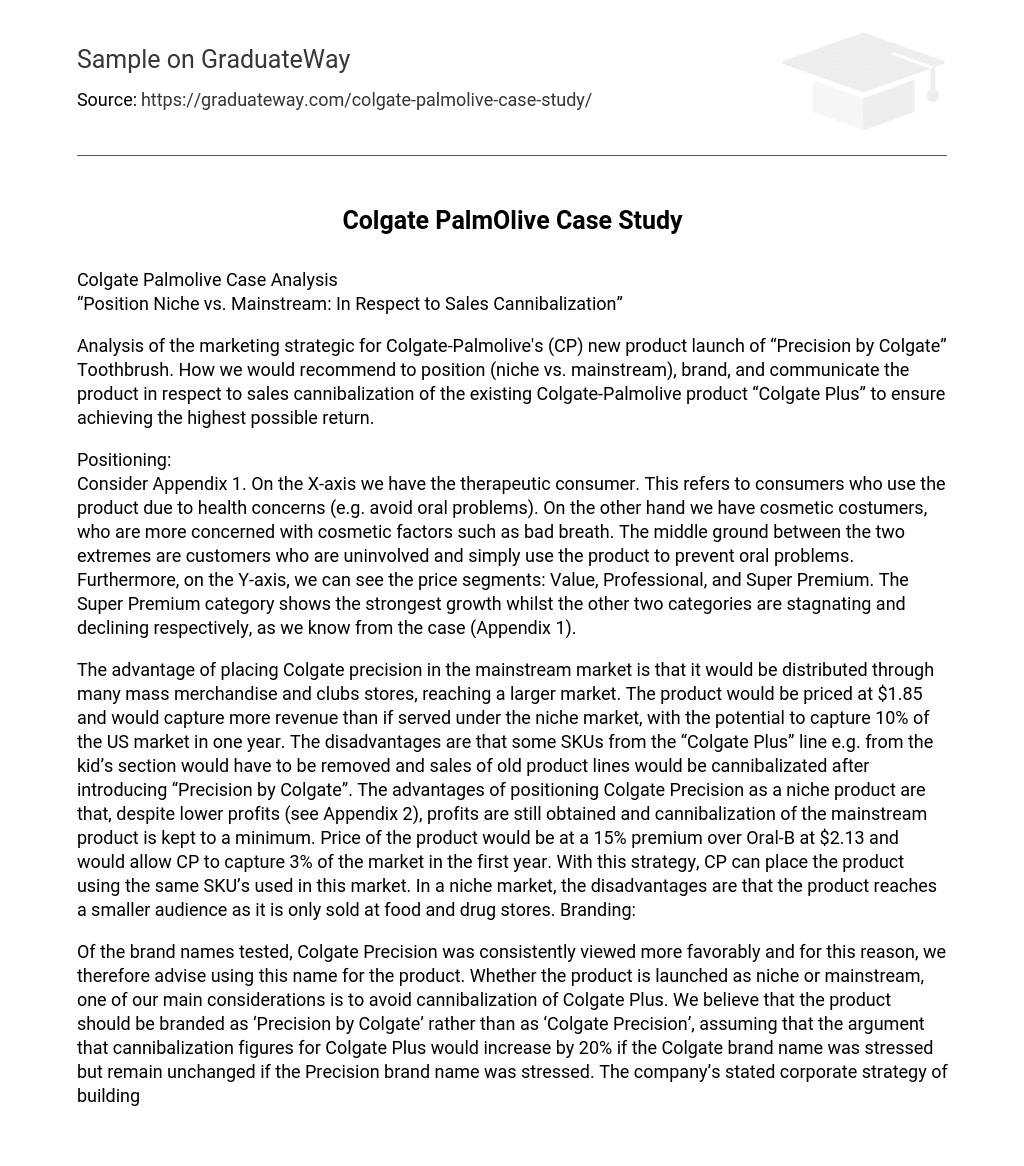Colgate Palmolive Case Analysis
“Position Niche vs. Mainstream: In Respect to Sales Cannibalization”
An analysis is being conducted on Colgate-Palmolive’s marketing strategy for the launch of their new toothbrush product, “Precision by Colgate.” The focus is on how to position the product (either as a niche or mainstream) and brand it effectively, while also considering the potential sales cannibalization of the existing Colgate-Palmolive product, “Colgate Plus.” The goal is to achieve the maximum possible return.
Positioning:
Please refer to Appendix 1 for an overview of positioning. The X-axis represents the different types of consumers. One end of the spectrum is the therapeutic consumer, who uses the product for health reasons such as avoiding oral problems. On the opposite end, we have cosmetic customers, who prioritize factors like bad breath. In the middle are customers who are not strongly aligned with either group and simply use the product to prevent oral problems. Additionally, the Y-axis represents the price segments: Value, Professional, and Super Premium. It is important to note that the Super Premium category is experiencing strong growth, while the other two categories are either stagnant or declining, as mentioned in the case (Appendix 1).
The presence of Colgate Precision in the mainstream market has the advantage of wider distribution through mass merchandise and club stores, allowing it to reach a larger market. The product’s price would be $1.85, leading to higher revenue potential compared to being in the niche market. In fact, it could potentially capture 10% of the US market in just one year. However, a drawback would be the need to remove certain SKUs from the “Colgate Plus” line, specifically those from the kid’s section. Additionally, introducing “Precision by Colgate” may cannibalize sales of existing product lines.
On the other hand, positioning Colgate Precision as a niche product also has its advantages. Despite lower profits (see Appendix 2), it still generates profits and minimizes the cannibalization of mainstream products. The product would be priced at a 15% premium over Oral-B, at $2.13, and with this strategy, Colgate Precision could capture 3% of the market in its first year. Furthermore, using the same SKUs as those utilized in this market allows for efficient placement. However, a disadvantage of the niche market approach is that it targets a smaller audience, as it is only sold at food and drug stores.
Branding:
Based on testing, Colgate Precision was consistently favored over other brand names. Therefore, we recommend using this name for the product. Our main consideration is to avoid cannibalization of Colgate Plus, whether the product is launched as niche or mainstream. To achieve this, we suggest branding the product as ‘Precision by Colgate’ instead of ‘Colgate Precision’. This decision is based on the argument that emphasizing the Colgate brand name would increase cannibalization figures for Colgate Plus by 20%, while stressing the Precision brand name would have no effect on these figures. By including the name ‘Colgate’, our company’s corporate strategy of building on the Colgate brand remains intact. The branding places the product in the super-premium bracket and targets consumers concerned about gum disease, as shown in the 4th concept test in Exhibit 17. The target customers are categorized as ‘Therapeutic’ due to their focus on oral hygiene rather than cosmetics. As for communication and promotion:
In terms of communication and promotion budget, CP is faced with two budget decisions: how to raise the total communication and promotion budget and how to distribute this raise among the Classic, Plus, and Precision productlines. According to the data of in-home usage tests, ‘77% of the testers claimed that Precision was much more effective than their current toothbrush’. This provides solid evidence that a mainstream positioning strategy can be highly successful for the product launch of Precision, but it also raises concerns that it will cannibalize Colgate Plus’s sales. Moreover, it is worth mentioning that consumers described the new look of Precision as “unusual”, resulting in mixed feelings. As shown in Exhibit 11, the weight of media advertising is on the rise, and the report indicates that the more test consumers were informed about Precision and its functionality, the more enthusiastic they became about the product.
Also, according to exhibit 8, a higher expenditure on media results in a larger shares of voice. However, since Precision is a unique product that provides a distinct sensation when consumed, and consumers’ willingness to purchase increases significantly after trying it, CP may consider increasing the promotional budget for the new product launch. This will enable potential customers to try Precision in-store with professionals present. In conclusion:
In conclusion, we suggest that the new product be named “Precision by Colgate” and be categorized as a therapeutic toothbrush in the super premium segment. We propose placing it on the shelf between the Colgate Plus and Oral-B product lines, which will support our niche positioning strategy. This strategy will allow us to gather sales data for the first six months and assess the impact on sales of the “Colgate Plus” product. Our total communication and promotion budget will be $11.2 MM, which will be allocated to TV advertisements, acquiring professionals, and promoting “Precision by Colgate” through samples, in-store displays, and retail advertising features. Our long-term strategy involves closely monitoring sales data and the cannibalization effect between the two products. After one year, we can decide whether to reposition “Precision by Colgate” in preparation for declining sales of the “Colgate Plus” as it reaches the end of its life cycle. By doing so, we aim to capture a significant market share in the broad super premium toothbrush market.





